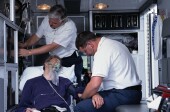A study of AEDs installed in Munich subways found they saved the lives of 12 people suffering heart attacks since the AEDs' installation in 2001. The defibrillators are increasingly common in public facilities, office buildings and transit stations across the United States and Europe.
The results of the study, the first to look at publicly accessible AEDs, were to be presented May 13 at Heart Rhythm 2009, the Heart Rhythm Society's annual scientific session in Boston.
The 44 defibrillators installed at 37 Munich stations come with written instructions and use voice and visual prompts to instruct would-be rescuers how to use them. They can only be operated after alerting emergency personal.
During the study, stored data in the AED were collected and analyzed after each use. Over 7.5 years, AEDs were used in 17 patients. Of 14 people having heart attacks, 12 -- 86 percent -- were resuscitated and admitted to the hospital. Three patients suffered other causes for collapse, and the device delivered no shock.
Eight (57 percent) were discharged from hospital without neurologic damage. Ventricular fibrillation, a severely abnormal heart rhythm, was the initial recording in 10 patients, eight of whom survived without neurologic damage.
One shock was inadequately delivered by the defibrillator operator. On all other occasions, defibrillators were operated adequately, and no technical malfunctions were observed, despite the strong electromagnetic field caused by the subway operation.
Total costs of the Munich subway resuscitation project were about $242,452, or $30,306 per survivor.
To use an AED, rescuers attach adhesive electrode pads to the victim's chest. Through these electrodes, the AED analyzes the electrical activity of the heart to determine if the heart should be shocked. If the electrodes detect a normal heart rhythm or a rhythm that shouldn't be shocked, the device won't deliver one.
"Systematic use of AEDs in the Munich subway system is highly effective and safe for the acute treatment of patients with cardiac arrest," according to the Heart Rhythm 2009 news release.
More information
The American Heart Association  has more on operating an AED.
has more on operating an AED.
SOURCE: Heart Rhythm 2009, press release, May 13, 2009
Copyright © 2009 ScoutNews, LLC
 . All rights reserved.
. All rights reserved.HealthDayNews articles are derived from various sources and do not reflect federal policy.
omhrc.gov does not endorse opinions, products, or services that may appear in news stories.



